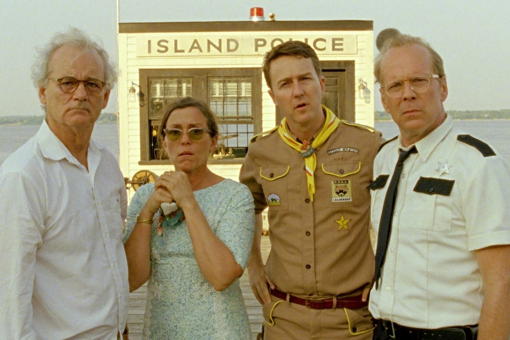By Meredith Alloway · May 27, 2012

In most all the reviews I sit down to write, I’m honest. I say what I want to say with no filters and no anxiety about whether or not people will agree or disagree. But with this review…I’m tentative.
It’s Wes Anderson! He has so many fans! He’s so brilliant! I don’t want to sound like a moron! Then I realized that that feeling…it all stemmed from pretension. Not mine, but Mr. Anderson’s. He’s a manipulator; so meticulous that his vision is prevalent in every single shot that he shoots. His precision convinces you that he’s a genius. His images, his eye for capturing the perfect color scheme in the perfect moment is beautiful. But is it real?
Wes Anderson has always held a place in my heart. And to you all, I will admit, I became teary eyed before Moonrise Kingdom even started. Nerd? Yes. I was ready to be taken on an adventure; a moving, traveling painting on the silver screen. That’s what Anderson’s work normally resembles after all.
It’s 1965 and deliciously vintage. It’s Charlie Brown characters incarnate, crackling record players and pouchy-cheeked kids. It’s childhood for those born in that era and it’s passed down stories for those with parents who grew up eating white bread and milk. Wes Anderson is on point.
It’s almost a Romeo and Juliet tale: Suzy (Kara Hayward) and Sam (Jared Gilman) decide to run away together. Sam, who we soon discover is an orphan, escapes his Khaki scout camp, putting his leader Scout Master Ward (Edward Norton) in much dismay. Suzy, flees her suffocating home with her mom (Frances McDormand) and dad (Bill Murray) and decides to meet Sam in a field nearby. Together, they begin their journey.
Soon, the neighboring search parties realize Sam and Suzy have fled together and join forces. An intriguing face for an Anderson film comes in the form of Captain Sharp (Bruce Willis). He leads the search, and also has a soft spot for Sam. He feels sorry for the boy, who’s clearly “emotionally disturbed.”
“I think why I made it is because it’s the first movie I made where I had a memory of a feeling that had stuck with me all my life that I’m kind of trying to recreate, which is being twelve years old…and being blindsided by falling in love. I don’t know if it’s falling in love, but something like that.” Anderson told Slate Magazine about his inspiration for the film and it’s clear that the story stems from a tender, personal place. There are moments between the two kids that are relatable for anyone. It’s that blossoming knowledge that you can love the opposite sex, but still not understanding how to do so exactly. It’s refreshing to see Anderson go to such a youthful territory, but, like all his films, it’s deeply sad. All the while you’re hoping that the end of this tale doesn’t share the same fate as those legendary star-crossed lovers from so long ago…
“How does he do it?” That’s the thought I have after every Anderson film. How does he make each color, moment, twitch so perfectly specific; where everything matches within his own singular vision? Does he drive his artistic staff, actors; the list goes on, insane? Every angle, every jolting camera zoom (so reminiscent of those dated-awful-but-wonderful 1960s movies), is planned. And yet he still manages to capture some piercing moments of truth as well. How does he do it? And then I also wonder: is this precision suffocating or does it set the film free?
I was touched. I cared for our hero Sam and our Heroine Suzy. But, I also felt removed. I was, as I expected, watching a moving painting. How invested could I be when everything is spoon-fed my way? This is Anderson and this is why I both love him and also feel unsatisfied in our affair. He sacrifices truth for aesthetic, and this leaves both him and his audiences constantly one-step removed from the heart of the matters at hand. Sadly this distance always exists when a work is too self aware (read: “self conscious”) of itself or its subject matter.